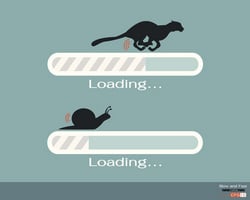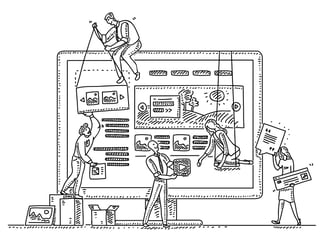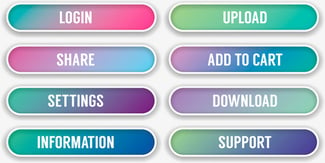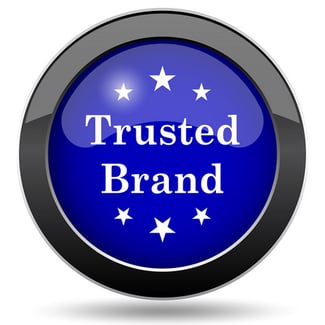
Average ecommerce conversion rates are only 2 to 3% across all sectors and devices, which means the vast majority of shoppers are leaving without making a purchase. Each of these empty-handed departures provides an opportunity for savvy marketers and business owners to substantially increase revenue.
For instance, for a business with 10,000 daily visitors and an average conversion rate of 2.5%, increasing conversions 0.5 points to 3.0% would generate an extra 50 orders a day. With an assumed average order value (AOV) of $100 those additional orders result in $5K of added daily revenue, or more than $1.8M annually.
A marginal increase from 2.5% to 3.0% may not seem worthwhile to pursue, but the aggregate effect over the course of a year can be astonishing. While larger companies benefit most from increases in conversion rates due to scale, businesses of all sizes can profit from incrementally improving conversion rates over time.
Regardless of how much traffic your site receives or what your AOV is, these elements are fundamental to increasing ecommerce conversion rates:
1) Site Load Time
 Slow load times will always diminish conversion rates.
Slow load times will always diminish conversion rates.
Online shoppers are notoriously impatient and with the multitude of options that are available to them, they do not have to wait to find what they are looking for online. Instead, they will return to the search engine results page and look elsewhere.
Powerhouse ecommerce retailers use this information to optimize the experience on their site by reducing site load times to provide a lightning-fast experience for users. In fact, Amazon boasts a 1.5 to 1.8 second load time for users despite the plethora of content that needs to load with every click.
While 2 seconds is generally considered the acceptable standard, recent reports show that the average ecommerce site has a 6 second load time, which means there is significant room for improvement in this area. According to Moz,
Reducing the average load time by 1.6 seconds would increase annual revenue growth by 10%.
... which is great news for any company looking to improve conversion rates.
Regularly running page load tests helps identify where the site is getting bogged down so that changes can be made to improve site speed. Typically, smaller businesses can find the most benefit in upgrading their hosting and optimizing their images for the web. Page load speed testing tools (both free and paid) can generate specific recommendations to improve site speed.
Checklist:
- Run page load speed tests
- Optimize images for the web
2) Simplicity
 According to “The Real Business of Web Design” by John Waters, 94% of negative feedback about websites is design-related, which means that shoppers are evaluating web design with an especially critical eye. However, these perceptions are not simply aesthetic in nature, they also influence the way consumers perceive the brand and its offerings.
According to “The Real Business of Web Design” by John Waters, 94% of negative feedback about websites is design-related, which means that shoppers are evaluating web design with an especially critical eye. However, these perceptions are not simply aesthetic in nature, they also influence the way consumers perceive the brand and its offerings.
An uncluttered homepage paired with a clean overall layout provides a simple user experience (UX) that increases conversion rates. Limiting the number of colors and fonts used on the site minimizes distractions, allowing for a more focused shopping experience. Carrying this through crucial design elements like the header, footer, and homepage slideshow creates simplistic consistency across the site to allow for better traffic flow. Opting for a more austere appearance gives more weight to each design element that is featured, funneling traffic more effectively along conversion paths.
Checklist:
- Remove any unnecessary items from the homepage
- Limit use of fonts and colors
- Design for the conversion funnel
3) Intuitive Layout
 Visitors expect to see a somewhat standard layout across all websites, the hallmarks of which are a:
Visitors expect to see a somewhat standard layout across all websites, the hallmarks of which are a:
- Logo in the top left corner
- Header that contains a search bar
- Top or left navigation bar with product/service categories and subcategories
- Footer with useful links
This logical structure grounds visitors with the essential elements required to navigate the website to make a purchase.
Organizing the website layout to facilitate conversions should be a top priority. Inform decisions with data from UX testing to improve on the existing layout and make ongoing tweaks. Take user feedback from focus groups and customer experience surveys into account as well.
Checklist:
- Design the header, footer, and navigation menu logically
- Conduct UX testing
4) Unique Content
 Instead of using product descriptions from the manufacturer or recycled content from competitors and partners, write unique content for each page of your website. Content should vary from page to page and from other pages elsewhere online. Effective search engine optimization (SEO) relies on unique content for search engines like Google to index and rank.
Instead of using product descriptions from the manufacturer or recycled content from competitors and partners, write unique content for each page of your website. Content should vary from page to page and from other pages elsewhere online. Effective search engine optimization (SEO) relies on unique content for search engines like Google to index and rank.
Content, however, should always prioritize people over search engines. Write helpful, useful, actionable content for a specific audience to achieve something that will resonate with your target demographic. Think beyond the sale to provide value for searchers and trust that value to pull consumers in and result in a sale rather than pushing the sale on them.
Checklist:
- Include unique content on each page
- Provide valuable content for searchers
5) Brand Story
 An ecommerce brand story should convey who a business is, what it does, and what sets it apart from the competition. The goal is to use this story to make the brand more personable. As the classic marketing adages say, "People don’t buy from brands, they buy from people” and “People don’t buy your product, they buy your story.”
An ecommerce brand story should convey who a business is, what it does, and what sets it apart from the competition. The goal is to use this story to make the brand more personable. As the classic marketing adages say, "People don’t buy from brands, they buy from people” and “People don’t buy your product, they buy your story.”
This brand story should be told throughout the site not just on the About Us page. Routine elements like a logo, sales copy, and product descriptions aid in weaving a brand narrative to educate visitors and convince them to buy. Keeping the voice consistent solidifies the brand perception to bolster conversion rates among consumers.
Checklist:
- Use the brand story to personify the brand
- Include a value proposition
- Fully integrate the brand story into the web design
- Keep a consistent brand voice
6) Calls-to-Action (CTAs)
 Use CTAs to get visitors to take a series of desired actions to result in a conversion. With the average online purchase requiring 22.1 clicks to accomplish, CTAs are essential for helping visitors navigate ecommerce sites to achieve conversions.
Use CTAs to get visitors to take a series of desired actions to result in a conversion. With the average online purchase requiring 22.1 clicks to accomplish, CTAs are essential for helping visitors navigate ecommerce sites to achieve conversions.
Walk consumers through what to do next to control traffic flow, but do not overuse them. Including too many CTAs on a website clutters the appearance and forces them to compete for visitors’ attention. The result is a muddled sales funnel that can hurt conversion rates instead of improving them. Decide which action is the most important on each page and coordinate CTAs across multiple pages to hand traffic off logically to each subsequent page on the path to a conversion. This streamlined approach effectively funnels traffic towards conversion goals.
Checklist:
- Use CTAs sparingly
- Align CTAs to funnel traffic into converting
7) Trust Signals
 Online stores fight the battle of perception every day because unlike physical storefronts that have built-in credibility, ecommerce businesses must prove to visitors that they are trustworthy. According to CXL Institute, 42% of shoppers worry about security while shopping online. Consumers will not shop from businesses that seem untrustworthy, which means that assuaging this doubt is crucial to improving conversion rates.
Online stores fight the battle of perception every day because unlike physical storefronts that have built-in credibility, ecommerce businesses must prove to visitors that they are trustworthy. According to CXL Institute, 42% of shoppers worry about security while shopping online. Consumers will not shop from businesses that seem untrustworthy, which means that assuaging this doubt is crucial to improving conversion rates.
At the very minimum, ecommerce stores need an SSL certificate to encrypt communications between the server and browser. (This is what generates the https that precedes a domain name in a secured URL.) However, since an SSL can be obtained for a nominal fee, additional trust signals are needed to vouch for a website’s authenticity.
Awards, industry accolades, BBB accreditation, positive ratings, honest reviews, and certifications signal to visitors that the website they are visiting can be trusted. Including these seals in the navigational menu or header ensures that they will display to visitors regardless of where they enter the site for the first time.
Displaying contact information and staffing help channels like customer service lines and live chat creates an additional layer of trustworthiness.
Checklist:
- Obtain an SSL
- Display trust seals
- Include contact information (email, toll-free phone number, mailing address, and live chat)
8) Product Images
 Consumers will not buy products if they are unsure whether items fit their needs or desires. Reducing purchase anxiety requires getting a good view of the product to pair with product descriptions and specifications.
Consumers will not buy products if they are unsure whether items fit their needs or desires. Reducing purchase anxiety requires getting a good view of the product to pair with product descriptions and specifications.
Web images should replicate the palpable process of shopping in a traditional retail store. High-quality images from multiple angles that allow zooming in on specific details give shoppers a similar hands-on experience. Showcasing products in use is a great way to differentiate them from competitors’ offerings and highlight their benefits.
Crowd-sourcing product photos gives products an authenticity that branded images inherently lack. Ask customers to submit photos in conjunction with reviews. Incentivize submissions from verified purchasers by giving away products and/or featuring top photos in social media and marketing communications.
Checklist:
- Always use high-quality images
- Include images from multiple angles
- Integrate a zoom feature
- Ask customers to submit their own images
9) Checkout Process
 Even in the absence of errors or glitches the checkout process itself can stymie conversions or reduce average order value (AOV), constricting revenue growth.
Even in the absence of errors or glitches the checkout process itself can stymie conversions or reduce average order value (AOV), constricting revenue growth.
A conversion optimizing ecommerce cart should add products without redirecting shoppers away from product and category pages. This soft add to cart feature encourages consumers to shop for additional products before checking out. The result is a higher AOV and lower shopping cart abandonment rate.
The shopping cart icon should dynamically update the number of products in the cart as well as the amount remaining until a free shipping threshold is reached. Including this information reassures shoppers that the products they intend to purchase have been added to the cart and incentivizes them to keep shopping to earn free shipping.
Do not require that shoppers create an account to make a purchase. Always include a guest checkout option for shoppers that are in a hurry or prefer not to have their personal information saved.
A one-page checkout is ideal, but in cases where a multi-page checkout is necessary, including a progress bar to give shoppers a sense of where they are in the process helps to retain consumers through the entirety of the checkout process.
During checkout include multiple payment and shipping options. For each shipping option, include prices and guaranteed delivery times. Important information like shipping timeframes helps shoppers make the right selection for their individual needs.
Following up with shoppers that have abandoned shopping carts is not always possible, but in cases where return shoppers have left products behind, email them with a promotional offer to incentivize them to return.
Checklist:
- Use a soft add to cart function
- Display total remaining until free shipping is achieved
- Allow guest checkout
- Use a one-page checkout
- Provide shipping cost and scheduled delivery timeframe
- Follow up on abandoned shopping carts
Improving web conversion rates does not happen immediately – it is a process that occurs over time. Making small, methodical changes and conducting testing to analyze the results is key to finding the right solution for your business. While gains may not always be linear in nature, overall changes should trend upward as a result of conversion-focused tactics.
Did you find this helpful?
You can download the PDF version and use as a checklist to improve your ecommerce conversion rates. Get it here >
About the Author
 Kate Pierce is the owner of LionShark Digital Marketing LLC, a West Michigan digital marketing company.
Kate Pierce is the owner of LionShark Digital Marketing LLC, a West Michigan digital marketing company.
Before starting her own venture, she cut her teeth in marketing at the world’s largest ecommerce provider, giving her valuable insight into ecommerce topics and trends.
Her areas of expertise include web copywriting, search engine optimization, and business blogging. She lives in the Grand Rapids area with her husband and two incredibly cute children.